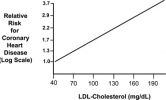Eddy Edson
Well-Known Member
- Relationship to Diabetes
- Type 2

There is urgent need to treat atherosclerotic cardiovascular disease risk earlier, more intensively, and with greater precision: A review of current practice and recommendations for improved effectiveness
Atherosclerotic cardiovascular disease (ASCVD) is epidemic throughout the world and is etiologic for such acute cardiovascular events as myocardial in…
 www.sciencedirect.com
www.sciencedirect.com
For LDL, the lower the better, the earlier the better. It's the emerging expert consensus, no matter what the Internet or your GP believe.
There has been compelling and convincing justification for some time that an approach that includes keeping plasma atherogenic lipoproteins low from early in life will greatly reduce risk for ASCVD.
...
Humans were never meant to harbor the low-density lipoprotein cholesterol (LDL-C) levels that are now commonplace. ...The fact that animals, non-human primates, and humans who maintain low cholesterol levels from early in life [66] have very little atherosclerosis all suggest that a ‘normal’ non-atherogenic LDL-C level is 20-40 mg/dl [ie about 0.5 - 1.0 mmol/L]. That is of course difficult to achieve in a modern society and, as described herein, is not necessary for most people.
...
Based on the log-linear relationship of LDL-C to the hazard ratio for an acute ASCVD event, the LDL-C level where there is no excess risk occurs is approximately 38 mg/dL or 1 mmol/L [67] (Figure 1). This value is consistent with the LDL-C levels observed among hunter-gatherer populations [68,69] In the Framingham Study, the average LDL-C of a man presenting with an Acute Coronary Syndrome (ACS) is approximately 150 mg/dL [70] [about 4 mmol/L] In the Cooper Center Longitudinal Study, even when LDL-C at baseline was < 100 mg/dL [about 2.5 mmol/L], there was a continuous rise in risk for Coronary Heart Disease (CHD) mortality over a mean follow-up time of 26.5 yrs [71] [72] Hence, it is crucial that exposure to atherogenic lipoproteins be dramatically reduced early and over the long-term.

Atherosclerosis begins in earliest childhood, sometimes even during gestation, presenting as yellow streaks in arterial walls [98], [99], [100], [101], [102]. It is a chronic disease: absent intervention, it slowly progresses throughout life, unevenly, sometimes rapidly [16], but inevitably worsening over time [18,[103], [104], [105], [106], [107], [108]] ... Previously believed to just be part of normal aging, atherosclerosis is actually a pediatric disease that progresses into adulthood [111], [112], [113], [114], [115]. Advanced disease recognized in very young people was observed in young men killed in Korea and Vietnam, as well as victims of trauma as young as 20-25 years of age. [116] Those fatty streak lesions in early childhood are usually the sites of more advanced lesions later in life [117]. ...Childhood risk factors have been shown to predict future clinical atherosclerotic disease by midlife [118].
...
Mammals, primates, those living indigenous lives away from ‘modern civilization’ [66], and those with mutations that cause extremely low LDL-C from birth [121] develop little or no significant atherosclerosis [122] The fact that animals, non-human primates, and humans who maintain low cholesterol levels from early in life [66] have very little atherosclerosis all support the conclusion that a ‘normal’ non-atherogenic LDL-C level is below 38 mg/dl [1.0 mmol/L], as noted previously. Other than those with genetically low LDL, what those with little or no atherosclerosis have in common from birth are: [1] low intake of saturated fats, salt, and sugars and other refined carbohydrates, [2] primarily plant-based diets, [3] absence of harmful substance abuse and less polluted environments, and [4] physically active, non-sedentary lives.
...
Even when LDL-C is extremely low, there is no impairment of cellular cholesterol production and utilization within the brain because the brain produces its own pool of cholesterol [130], as do all cells in the body. No tissues depend on cholesterol transfer from LDL-C
...
While apolipoproteins play the dual role of distributing triglyceride and cholesterol to systemic tissues, their primary role is to facilitate excretion of cholesterol from the bloodstream and the body. [132] Atherosclerosis occurs when those mechanisms are inadequate and lead to excess circulating cholesterol that is deposited in the intimal space of medium to large arteries by transcytosis of LDL particles and atherogenic apo B remnants [18,133].
...
Based on the preponderance of evidence, it seems best to set LDL-C goals below 40 mg/dl (1 mmol/dl), or even lower for even higher risk. This is also consistent with current recommendations from the European Society of Cardiology/European Atherosclerosis Society guidelines for the management of dyslipidemia [156] However, that would likely be challenging to achieve widely, but as will be shown in this review, in those with no enhancing risk factors, keeping LDL-C below at most 85 mg/dl [2.2 mmol/L] from birth throughout life would likely delay onset of complications until age 100. This has been derived from experience with those with a heterozygous deficiency in PCSK9. For those with additional risk factors or more advanced atherosclerosis, keeping LDL-C below 38 mg/dl [1.0 mmol/L] (depending on severity) would also likely maintain good health until very late in life.
...
Many studies have confirmed that the lower the LDL-C, the lower the risk and the fewer complications of atherosclerosis, with no evidence of any clinically significant harm no matter how low the LDL-C level
Last edited:

